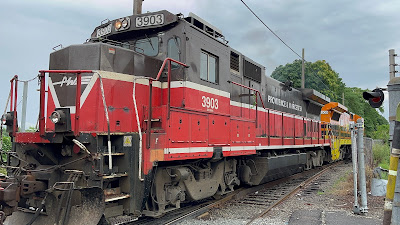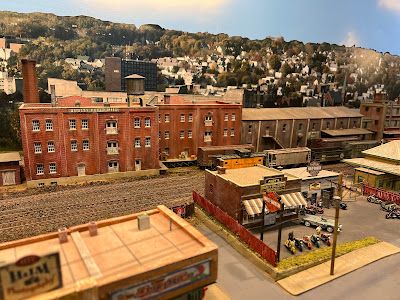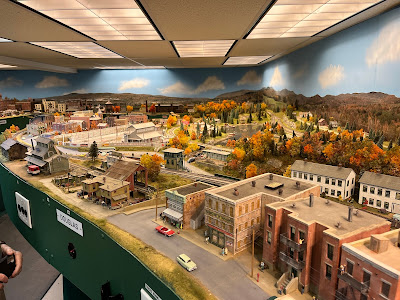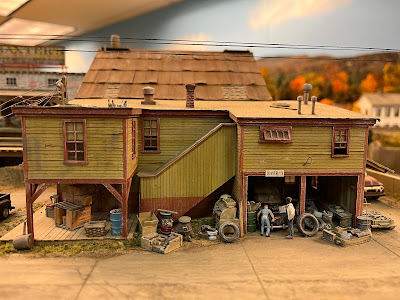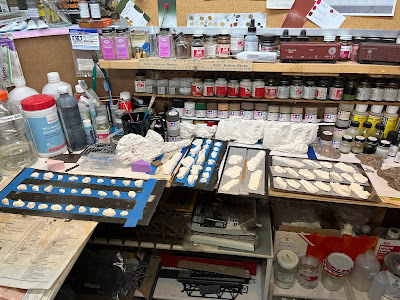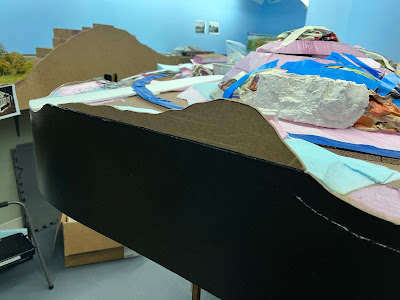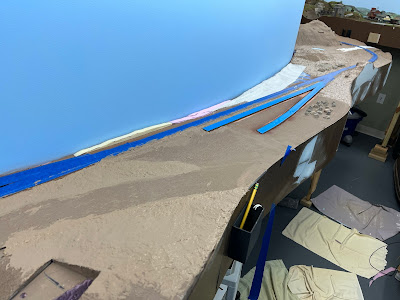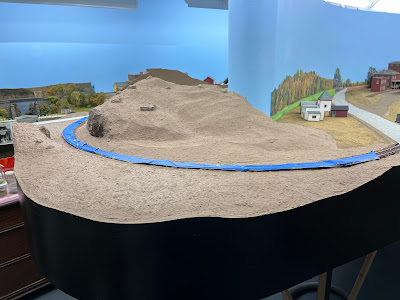Wednesday, July 19, 2023
Monday, July 17, 2023
Painting Sculptamold, Filling Trenches, Coloring Rocks
As I mentioned in my last post, I've been striking a different balance between pre-work workouts and pre-work scenery work. For better or for worse, the scenery has been winning more often than the exercise.
So while my waistline may not be showing any positive effects of my current pre-work routine, the layout is certainly showing some signs of progress. Emulating my friend Tom Jacobs, "An Hour a Day" keeps the layout moving forward. Here's the latest since last time...
 |
| I added some skimcoats of plain ol' Sculptamold over top of the "popcorn"-effect ground goop fail to even things out a bit. |
 |
| Once dry, I painted it all with my "dirt" colored paint (custom color matched to dirt I found/sifted from the area - turns out it's Behr "Davenport Tan" Go figure...) |
One of the benefits of having "too much" layout (and, depending on your perspective, the downside of same), is that there's always something to do. So, while waiting for all the Sculptamold and paint to dry from Old Deep River Road north to East Haddam, I decided to turn my attention to Old Saybrook.
Thursday, July 13, 2023
Throwback Thursday: Wood Ops Session & Jason Fontaine's Layout
Hopefully you've noticed the progress on the layout lately . . . As I mentioned in my last post, I've been exchanging before-work workouts for before-work layout work and I've been making steady progress. But it's time to swing the mental health pendulum back a bit since 1) while mental fitness is important, so is physical fitness - and I haven't been on the bike or treadmill in over a week; and 2) (and, I'll confess, more due to this>) I really should wait until all the Sculptamold, plaster, and ground goop fully cures before proceeding. So while I wait for that, I'll get back in the saddle at the sunrise. . .
But hearing about my workout schedule is likely the LAST reason you'd be here . . . so let me turn back the clock a few weeks for this edition of Throwback Thursday and tell you about a day in late June when I got to operate on a cool switching layout and got to visit an amazing basement-filling empire that's soon to be retired . . .
 |
| Speaking of Elwell influence, folks that saw the Hoosac Valley will find this scene especially familiar. |
 |
| While the rugged mountain scenery around the helix is more "northern" rather than "southern" New England, there's no mistaking the season . . . |
 |
| Seldom attempted, and never - to my knowledge - actually accomplished . . . a full HO scale race track, complete with spectators! |
 |
| Fully strung power lines are an Elwell - and now apparently also a Fontaine - trademark. |
 |
| I found the elevation changes all around the layout particularly compelling - no flat-top tables here... |
 |
| This diner has a full interior and lighting so you can see it. |
Wednesday, July 12, 2023
Sunday, July 9, 2023
Scenery Base Progresses Northward, Despite Ground Goop Gotchas...And Mind the Mental!
I'm happy to report that the "flow" of scenery work I discussed in my last post is continuing northward from the Old Deep River Road area up to Deep River itself. Unfortunately though, while I'm in a scenery flow, my ground goop recipe seems to have ground to a halt . . .
Ground Goop Gotcha
Tuesday, July 4, 2023
Progress Report: Scenery Advances at Old Deep River Road
I can't believe it's already been over two whole weeks since this year's NERPM - and what a busy couple of weeks it's been! In addition to making some major (and hopefully final, for this season) progress on the house and yard, my buddy Pete and I got to visit Jason Fontaine's amazing layout and I got to operate on friend Alex Wood's layout. Those activities will be the subject of a future post - but for now, I have some fairly major progress to report since my last update way back on May 21(!).
When I haven't been otherwise occupied, I've had the bit between my teeth and been making some progress on scenery north of Essex, coming into Deep River . . .
Old School Hardshell
- I used Woodland Scenics "Super Strength Plaster" (C1199) mixed according to the directions, and poured into a variety of rubber molds (WS C1231, C1232, etc).
- Once the castings are done (24hrs or so), I pop them out of the molds and color them using washes of raw sienna, raw umber, and black (detailed process here)
- 2 parts Sculptamold
- 1 part brown latex paint (I use a Home Depot/Behr color called "Davenport Tan")
- 1/2 part Elmer's Glue All
- 1/2 part water - just enough water to make a oatmeal consistency







